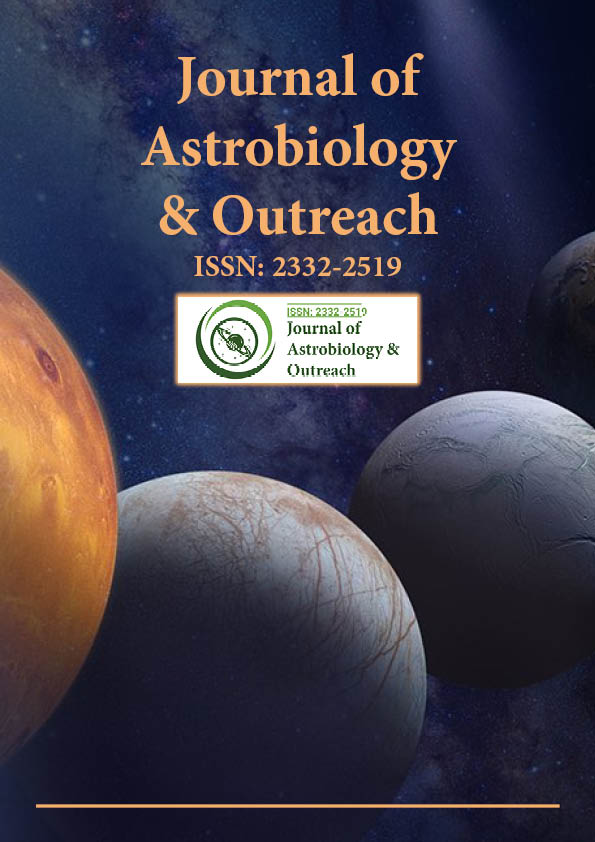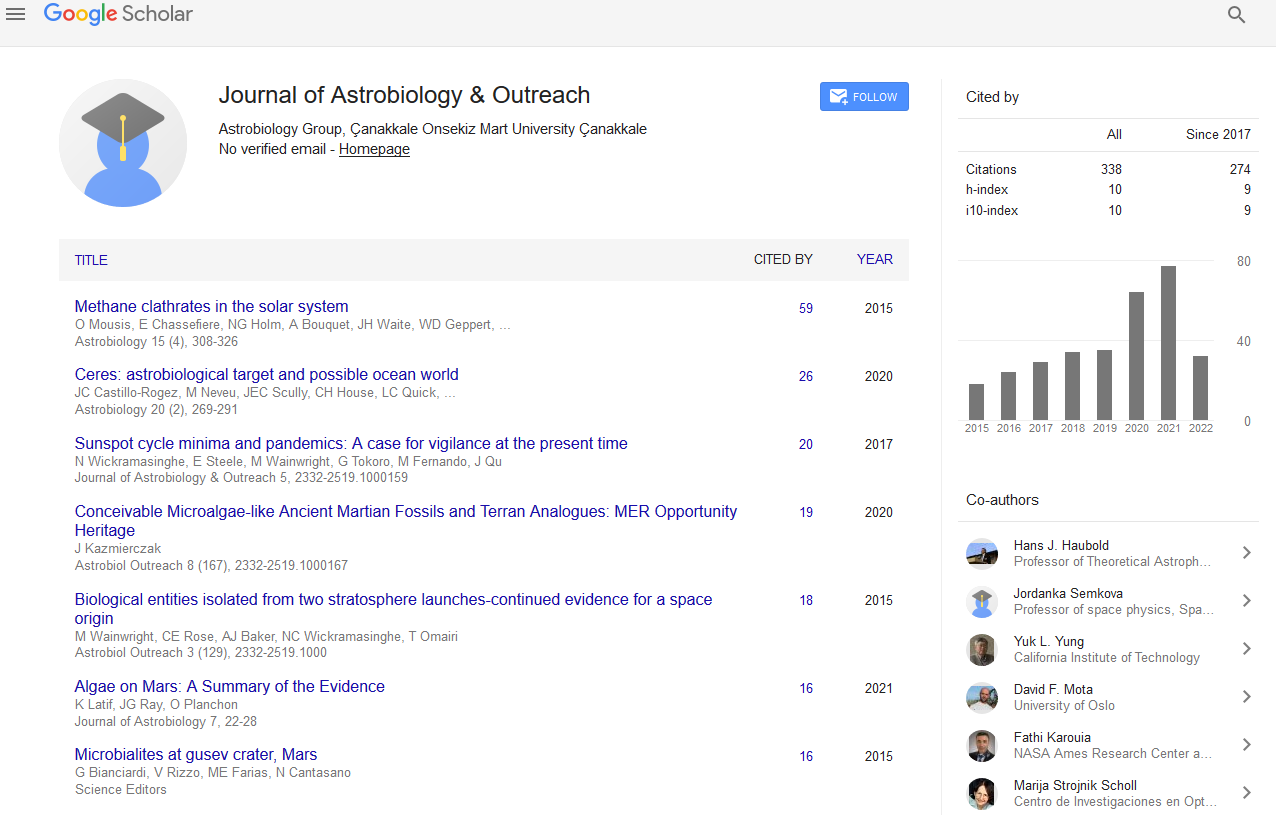Indexed In
- Open J Gate
- Academic Keys
- JournalTOCs
- RefSeek
- Hamdard University
- EBSCO A-Z
- OCLC- WorldCat
- Google Scholar
Useful Links
Share This Page
Journal Flyer

Open Access Journals
- Agri and Aquaculture
- Biochemistry
- Bioinformatics & Systems Biology
- Business & Management
- Chemistry
- Clinical Sciences
- Engineering
- Food & Nutrition
- General Science
- Genetics & Molecular Biology
- Immunology & Microbiology
- Medical Sciences
- Neuroscience & Psychology
- Nursing & Health Care
- Pharmaceutical Sciences
Perspective - (2024) Volume 12, Issue 3
Astrobiological Insights from the Moon and Organic Survival in Space
Marie Dubois*Received: 30-Aug-2024, Manuscript No. JAO-24-27918; Editor assigned: 02-Sep-2024, Pre QC No. JAO-24-27918 (PQ); Reviewed: 16-Sep-2024, QC No. JAO-24-27918; Revised: 23-Sep-2024, Manuscript No. JAO-24-27918 (R); Published: 30-Sep-2024, DOI: 10.35248/2332-2519.24.12.359
Description
The Moon, with its desolate yet interesting field, provides a unique laboratory for studying the interactions between organic compounds and the extreme conditions of space. Understanding the radiation-induced destruction of organic materials on the lunar surface has significant implications for astrobiology, planetary science and the interpretation of organic signatures on other celestial bodies. This perspective explores the significance of experimental studies in this domain, emphasizing their relevance to understanding the stability of organic compounds in space and their implications for the search for life beyond Earth.
The Moon's surface is characterized by extreme conditions, including exposure to solar wind, cosmic rays, ultraviolet radiation and the absence of a protective atmosphere. These factors create an environment where organic molecules are subjected to intense radiolytic and photolytic processes. While the Moon itself is not considered a candidate for hosting life, its surface serves as a natural platform for studying the survival and degradation of organics in space-like environments. Experimental investigations into these processes are essential for understanding the transformation of organic compounds delivered to the Moon by comets, asteroids, or interplanetary dust.
One of the critical aspects of such studies is their relevance to astrobiology. Organic molecules, including amino acids, nucleobases, and other complex compounds, are considered building blocks of life. Their stability under radiation exposure is an important factor in determining their potential to seed life on habitable worlds. Experimental simulations that replicate lunar conditions, including high-energy particle irradiation and ultraviolet exposure, provide valuable insights into the chemical transformations and degradation pathways of these molecules. These experiments help establish whether organic compounds can remain intact long enough to be preserved in lunar regolith or if they are rapidly destroyed.
Moreover, the findings from these studies have direct implications for interpreting data from lunar exploration missions. As space agencies, including NASA, ESA and CNSA, intensify their efforts to explore the Moon, the detection of organics on the surface could provide clues about their origin. However, distinguishing between indigenous organic compounds and those altered or destroyed by radiation requires a detailed understanding of radiation-induced chemical processes. Experimental results can help refine analytical techniques, ensuring that potential biosignatures are correctly identified and contextualized.
The radiation-induced destruction of organics on the Moon also offers insights into the broader dynamics of space weathering. The interactions between radiation and lunar materials not only affect organics but also influence the formation of secondary compounds, such as carbon monoxide, carbon dioxide and other volatile products. These secondary species can diffuse into the regolith or escape into space, modifying the surface chemistry of the Moon. Understanding these processes is vital for reconstructing the Moon’s chemical history and assessing the potential for similar processes to occur on other airless bodies, such as Mercury, Europa, or asteroids.
Experimental studies in this field are particularly relevant to the preservation of organic materials on other celestial bodies. For example, the icy moons of Jupiter and Saturn are considered prime targets in the search for life, yet their surfaces are exposed to intense radiation from their parent planets' magnetospheres. By studying the Moon as an analog, researchers can extrapolate the results to these distant environments, estimating the likelihood of detecting unaltered organic compounds on icy surfaces or within subsurface oceans.
As the global space exploration community advances its understanding of radiation-driven processes, international collaborations can play a significant role in standardizing experimental protocols and sharing data. By combining resources and expertise, researchers can address gaps in our knowledge and develop a comprehensive understanding of the stability of organic compounds in space.
In conclusion, experimental studies on the radiation-induced destruction of organic compounds on the Moon provide critical insights into the resilience and chemical evolution of organic materials in space. These investigations have far-reaching implications, from analyzing lunar exploration data to guiding the search for life on other worlds. They also highlight the importance of the Moon as a platform for astrobiological research.
Citation: Dubois M (2024). Astrobiological Insights from the Moon and Organic Survival in Space. J Astrobiol Outreach. 12:359.
Copyright: © 2024 Dubois M. This is an open-access article distributed under the terms of the Creative Commons Attribution License, which permits unrestricted use, distribution, and reproduction in any medium, provided the original author and source are credited.

